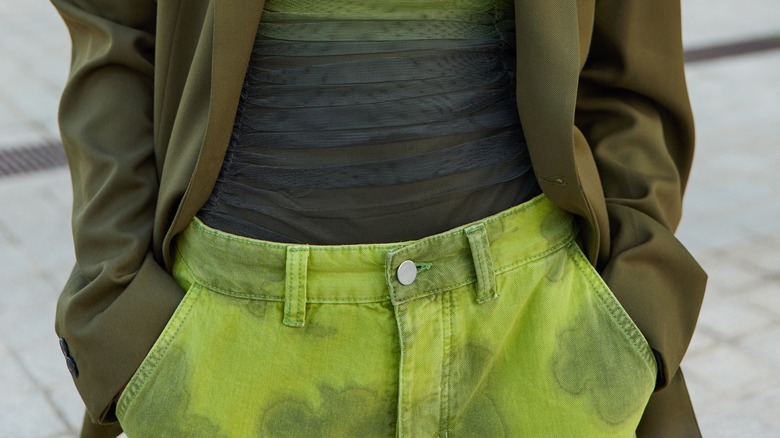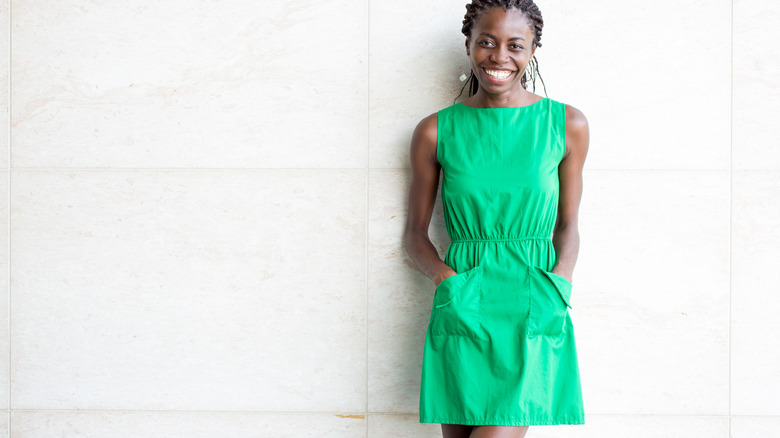Pocketless Women's Clothing Isn't Just An Inconvenience, It's A Patriarchal Pain Point
Should a perfect feature have ever existed in women's fashion, pockets might be it. Although it can be strange to consider, there was a dark, dark time when pockets did not exist. And pockets were not even common on women's clothing until the 1800s. At the time, the fashion was to wear tie-on pockets, pouches that would sit underneath a woman's dress with varying degrees of access.
Women would carry anything from keys to sewing kits, to other small household items, and even money in their pockets. A physical manifestation of women's interior lives, pockets represented autonomy and privacy — two concepts that would be hard-won for women throughout history. Over centuries, the real reason women's clothes rarely had pockets boils down to the fact that women's liberation would be a threat to the status quo. Besides, women's husbands had pockets, so why would she need her own?
Women rallied for pockets; the Rational Dress Society advocated for pockets as a convenience of common sense. The advent of the Suffragette Suit in 1910, laden with pockets, dared to revolutionize women's dress. But even now, reasonable pockets on women's clothing are a struggle. How has such an innocent addition of fabric caused so much contention? And how does it manifest today?
Pocket problems of today
Today, gender norms continue to be both challenged and broken down. Concerns such as missing pockets, or the designation of certain colors to certain genders — we're looking at you, pink and blue — feel both dogmatic and outdated. We want to scream at clothing manufacturers, "Keep up! How is this still a thing?"
While the pocket problem is nowhere close to the same scale as the Supreme Court's decision to overturn Roe v. Wade, or to anti-trans legislation being lobbied across the United States, it can be a nagging result of women's inequality. It is a reminder that women are expected to perform specific gender roles, including how they dress, and that women's needs are seen as less pressing than those of men. Denying women larger pockets, or pockets at all, denies the socio-political history of the pocket. It signals that women should be content with what they have and should not dare to want more.
The pocket problem does not just apply to women, however. Clothing can be a major factor in gender expression. Excluding suitable pockets from women's clothing can be frustrating for anybody who wants to wear it without sacrificing convenience. Besides, small pockets are just not practical. Research conducted by Pudding showed that pockets on women's jeans are 48% shorter than those on men's jeans, and 6% narrower, even though all of the jeans measured had the same size waistband.
Further pocket considerations
While the case of women's pockets is rooted in patriarchal expectations for women, other factors have come into play. Fashion designer Emily Keller explains to The Sun that retailers do not have much incentive to make women's pockets any bigger. Smaller pockets need less fabric to make, thus cutting costs. And cheap fabric, often used by fast fashion brands, tends to be thinner, meaning that the pockets will be less than functional anyway. "The focus of cheap clothing tends to be the visual aesthetics and trendiness. With higher price points, comes thoughtfully designed pieces with a focus on timelessness, longevity, quality, and function, in lieu of trendiness," she says.
In other words, expect fast fashion to cater to what looks good, not what is practical. Others have taken a more conspiratorial approach. What if the bag industry is in cahoots with retailers, working together to sell more handbags by excluding pockets? Although this take might be a bit of a reach, one thing is certain. Women want better pockets, and women should have them.


